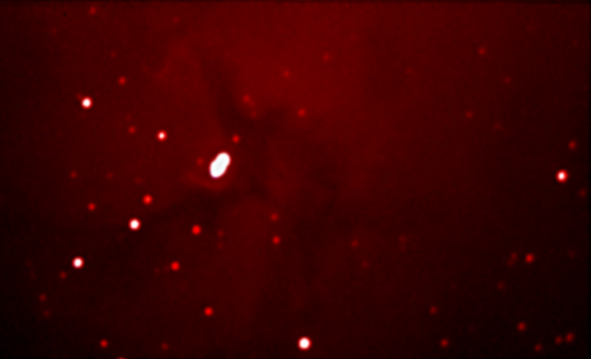
M20: Trifid Nebula

RA: 18hr 2min 36sec Dec: -23º 2' 00" Mag: 6 Distance: 5000 light-years Constellation: Sagittarius
This photo was taken on the 2nd of September, 2005. The same time and elevation constraints applied as with the M8 photograph, i.e. low over the horizon with obstructing trees looming in the way of the tracking. It was as clear a night as can be achieved in my part of the world, but to the south of my location lies the town of Abingdon with much sodium street-lighting. This is the bane of my astronomy-life - I believe nebulae in this part of the sky would be clearer to see with a nebula filter to weed out the sodium lighting. Again, as with M8, I believe a more encompassing shot of the Trifid could have been achieved with a wider field of view but I only have an f6.3 focal reducer and so was content to get the picture that I did - amazingly, for the relatively short exposure, I was able to distinguish the dust lanes which trisect the nebulosity to give it its name.
I obtained 6 raw images with the DSI and Envisage consisting of the following stacks: 5x30 seconds, 11x30, 20x30, 4x30, 13x30 and 17x30, thus producing a total exposure time of 35 minutes. The 6 raw images were combined with MaximDL and saved as an 8 bit tiff file which Adobe Photoshop could open. (For some reason, Photoshop 7.0 just 'sees' a black file if I save combined images from MaximDL in 16 bit format) The combined image was then processed in Photoshop as follows - histogram stretch using the Levels command in each of the R, G and B channels. Midtones were increased using the Curves command and finally the black contrast enhanced slightly by increasing the black level input for Luminosity (RGB) in the Levels command. No masking of the binary in the core of the nebula was carried out (perhaps I should have) and no Gaussian blur was applied.
Problems: a) needs longer exposure time - but I haven't been able (at this stage) to rectify the very slight tendency for the image to drift in the vertical axis. In terms of the telescope, the barrel appears to track upwards as if the declination has been set too high, but then the Goto function seems to be highly accurate still. This is baffling. I think it must be the way I am setting the home position prior to Two-Star alignment. b) Again, I would love to be able to carry out software deconvolution of the image to get better star images and better point-spread. See the 'Software' part of this website.
HOME PICTURES: Deep Sky PICTURES: Solar system PICTURES: Wide field